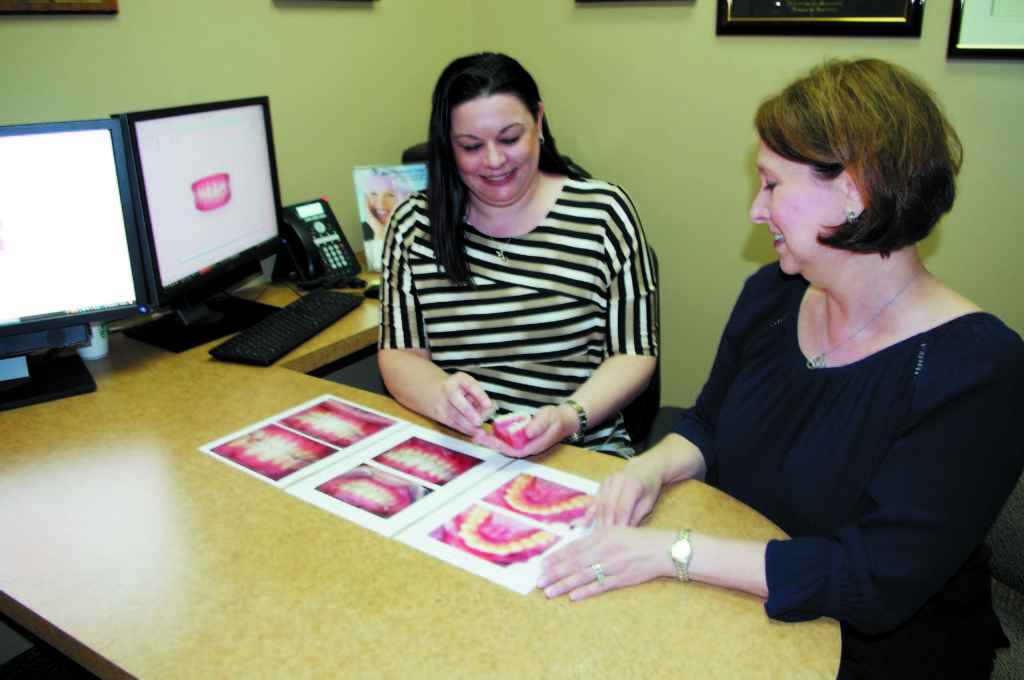
By Debbie Hilcove
Although family dentistry is the focus of Tempe SmileDesign, Dr. Roxane Huber and Dr. Stacy Tracy specialize in cosmetic dentistry, or “smile design.”
Tracy told Wrangler News she wanted to be a dentist from the time she was 9 years old. Playing on monkey bars, she slipped and damaged her teeth, requiring extensive oral surgery, followed by cosmetic dental surgery.
“Your smile is the focal point of your face….I can tell you from experience that you can change someone’s life by improving their smile,” Tracy said. Although cosmetic dentistry may not necessarily improve function, dental aesthetics can enhance a smile and probably encourage better oral health.
Some cosmetic procedures provided by Huber and Tracy include chip repair, whitening and porcelain veneers to improve the color, shape and size of teeth.
Many adults, ages 43-65, received tetracycline a children, resulting in gray-stained teeth, which can be covered by veneers.
Also, since teeth move gradually with age, many adults are opting for braces, rejecting traditional metal braces and choosing the Invisalign process. Developed in 1997, the process begins in a dentist’s office with an impression made of a patient’s teeth.
The impression is scanned into a computer. The dentist, referring to X-rays, uses the computerized model to plan incremental stages of clear, plastic trays to be worn over the patient’s teeth to move them gradually into the desired position.
Worn 22-24 hours daily for 6-18 months, the trays are removed before meals and before drinking anything other than water. Final successful alignment depends upon the wearer’s dedication to the process and commitment to wearing a post-procedure retainer.
In 2014, traditional dentistry encountered challengers to Invisalign. A startup, SmileDirectClub, offered at-home straightening services, beginning with a mail-in impression kit.
The customer receives a treatment plan with incremental stages of clear plastic aligners.
The process skips X-rays and dental visits, substituting online chats. It costs about $2,000, several thousand dollars cheaper than traditional dental supervision.
When the Invisalign patents expired in October 2017, several companies copied SDC’s lead, creating more competitors. In retaliatory marketing, SDC announced a partnership with Macy’s; an enterprise with the concert promoter, Live Nation; and a possible venture with CVS Pharmacy.
These online businesses, however, have been targeted with patent infringement lawsuits and with consumer alerts from the American Dental Association.
Commenting on at-home orthodontia, Tracy says, “There are many issues that can be encountered. Some people haven’t been to a dentist in many years. They could have decay or periodontal problems and not know it. They should not be embarking on self-treatment.
“Teeth are moved through the bone to straighten them. If there is not good bone support around those teeth, they can be moved out of the bone. These patients have no X-rays taken, and no one to tell them if they have problems that should be addressed before starting orthodontics. Joint issues can occur from leaving the bite incorrectly positioned as well. This isn’t an ‘access-to-care’ issue. It’s harmful to the patient if done incorrectly.”
She continues, “Orthodontics is complex and requires a great deal of knowledge to perform it correctly and in the safest way for the patient. It takes years of training and practice to become competent at taking impressions and to learn what is a good impression. And that is what makes for a good, well-fitting aligner.
“I’ve been doing this for 16 years and can tell you that things do not always go according to plan. Teeth don’t always move the way we expect them to.” Huber did not wear braces as a child, but currently wears the invisible trays to “see the process from a patient’s point of view.”
She says, “The “best candidates are adults. They have their permanent teeth and want better oral health.”
Nodding agreement, Tracy says, “It’s very doable. If someone wants Invisalign, we can find a way to do it. We’re both perfectionists. We’ll never say, ‘It’s good enough.’ We strive for perfection.
Both dentists and their staff support the ADA’s campaign, “Give Kids A Smile,” which provides dental care to underserved communities.
They also volunteer with the Arizona Dental Mission of Mercy, which aims to “provide charitable dental care and education to Arizonans to lower health risks and suffering for those in need.” The 2018 event will be held Friday, Dec. 7 and Saturday, Dec. 8 at the Arizona State Fairgrounds.
Information: tempesmiledesign.com or 480-829-8200 adafoundation.org/en/give-kids-a-smile and https://www.azmom.org.


